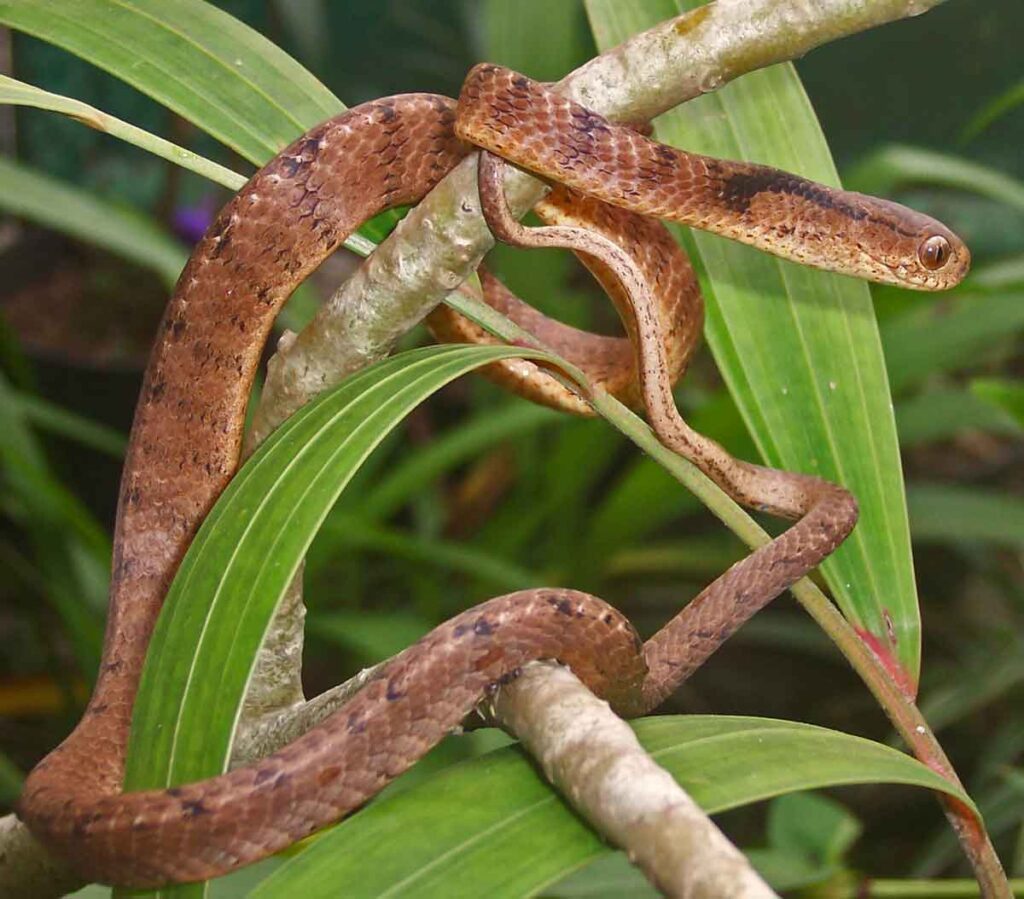
Content |
|---|
Origin / Distribution
The Keeled slug-eating snake (Pareas carinatus) is present in parts of southern China, Myanmar, Thailand, Laos, Cambodia, Viet Nam, Peninsular Malaysia (only in northern states), Sumatra, Borneo, Java and Bali. No records from Singapore.
Characteristics / Appearance
It has a remarkably sharp snout and relatively large eyes.. Its body is relatively thin and laterally compressed.. Its color is typically medium brown, with a pattern of darker spots and numerous narrow, broken bars. On the top of the head there are dark markings, that can form a clear cross shape, or they can be somewhat less defined. Its underside is pale yellow..
Habitat
This Keeled slug-eating snake broad-spectrum inhabits lowland and low-mountain forests up to the 1300 meters above sea level. It is nocturnal and has mainly arboreal habits..
Behavior
The Keeled slug-eating snake is a predominantly lowland resident. Rarely found near human settlements and farming areas. Its predominant habitat is forests.. Here the snake feeds at dusk and at night close to the ground. Snakes move very slowly. Their diet consists of nudibranchs and slugs..
When disturbed, sometimes curls into an S shape, lifts the front body off the ground and pushes the “adversary”, but usually without biting.
This species lays eggs. Females can lay between 3 and 6 eggs throughout the year. The pups measure between 15 and 18 cm when hatched.
Threats to the species
The Keeled slug-eating snake (Pareas carinatus) has recently been assessed by the IUCN Red List of Threatened Species in 2011. It is classified as Least concern.
The "Keeled slug-eating snake" in captivity
Video of the "Keeled slug-eating snake" |
|---|
The terrarium
Some measures of 40 x 35 x 60 cm. (width x depth x height) for the terrarium, illuminated and heated with a fluorescent tube and a parabolic radiator of 60 W. The terrarium may have peat plates on the bottom, as well as at the rear and on a side wall. A thick layer of soda clay under the peat plates serves as drainage and water storage to keep the peat moist at all times and thus ensure higher humidity. The Ficus benjamina and the Ficus pumila they take root in the peat and grow forming a tangled web in the terrarium. A few pieces of cork bark add more structure.
Drinking water can be an ornamental birdbath, and animals can be sprayed at least every three days. Depending on the season of the year (warmer in summer, cooler in winter), The temperature in the terrarium ranges from 22 and 32 °C during the day and 18 and 24 °C at night.
Food
The Keeled slug-eating snake is specialized in feeding on shelled snails. With their enlarged fork-shaped jaws they try to hold the prey by the soft body and lever it out of the shell by alternately retracting the two jaws..
Nudibranchs offered sporadically have so far only been accepted with great hesitation and only when very hungry. The snails that feed are the bright band snails or (Cepaea spp.), that can be found in almost all the field and have an adequate size. for the juniors, look for smaller snails. Bernstein the snail (Succinea putris), that can be found in wet meadows, offers a good alternative to the not always frequent juveniles of Cepaea due to its smaller size. The collection of young vineyard snails (Helix pomatia) is prohibited for reasons of conservation of the species.
Water snails have never been accepted as prey. Feeding the previously frozen snails or their bodies or soft parts proved to be extremely difficult.. It seems that, in addition to the olfactory stimulus, visual stimulation due to the slow movement of the live prey animal and the round shape of the snail shell also plays an important role in prey recognition.
Normally, the animals eat about eight snails once or twice a week. Feeding always takes place at night. If snails are introduced into the terrarium, snakes immediately begin to lick intensely. They then appear to follow the odor gradient in the air until they have the snails directly in front of them..
Buy one "Keeled slug-eating snake"
The price of a "Keeled slug-eating snake" at the exotic animal market, ranges between 200 – 300 EUR.
Videos "Keeled slug-eating snake"
|
|
|
|---|
Alternative names:
1. Keeled slug-eating snake (English).
2. Serpent mangeur d'escargot (French).
3. Gekielte Schneckennatter (German).
4. Serpente-comedora de lesmas (Portuguese).
5. "Serpiente comedora de babosas", Serpiente caracolera (español).
